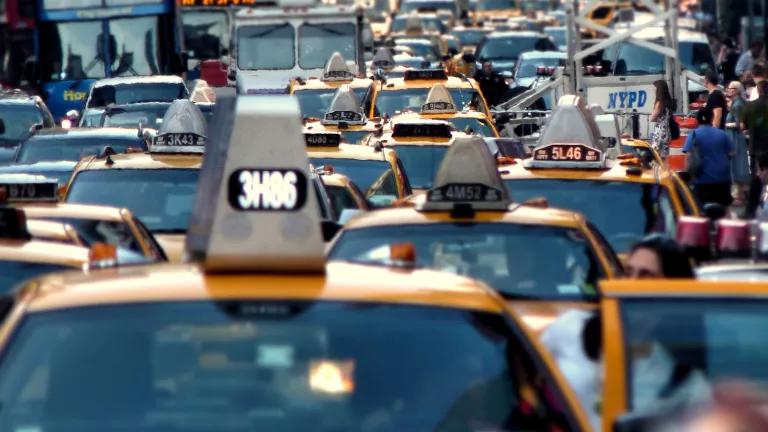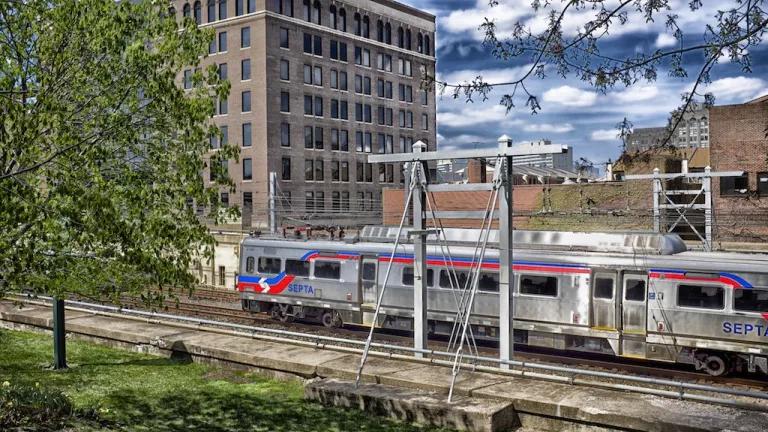Public Supports Northeast/Mid-Atlantic Clean Transportation

Photo: joiseyshowaa via Flickr under a Creative Commons license
After a series of public listening sessions across the Northeast and Mid-Atlantic region, the message is clear: the region’s businesses and residents overwhelmingly support efforts to clean up and modernize our transportation system—the way we move people and goods across the region.
That’s the lesson from a series of public listening sessions held in the region this year, in cities that include Albany, New York; Hartford, Connecticut; Wilmington, Delaware; and New York City. A fifth listening session is scheduled for August 27 in Largo, Maryland.
This message has also been confirmed by recent polling that shows 74 percent of Northeast and Mid-Atlantic residents want their state leaders to take action toward building a clean and modern transportation system that includes more electric vehicles, improved public transportation, and safe infrastructure for walking and biking.
Since April, seven states in the region—Connecticut, Delaware, Maryland, Massachusetts, New York, Rhode Island, and Vermont—and Washington, D.C. have been holding public listening sessions to solicit input on how to address the region’s transportation challenges. Last week at a listening session in New York City, the state of New Jersey got involved as well.
These listening sessions, which have been widely attended, have revealed both the need and the opportunity to modernize transportation, a crucial sector of our economy, in ways that will improve our daily lives, create jobs, save money, and address pollution all at the same time.
With strong public support, the region’s governors should take the next step by working together to develop a comprehensive plan to modernize transportation.
Why Transportation?
The Northeast and Mid-Atlantic region faces many transportation challenges, from traffic jams to crumbling roads and bridges, public transit systems in need of investment and repair, and unsafe roads for pedestrians and cyclists.
Our cars, trucks, buses, and trains further pollute our air with soot and smog. A recent NRDC report, Transportation Reimagined, found that soot pollution from the region’s vehicles causes more than 50,000 asthma attacks and 200,000 lost work days a year.
These same vehicles are also the largest source of climate-altering pollution, producing even more of this pollution than the region’s power plants. Unless we address this pollution threat, we will be unable to avoid catastrophic climate change.
But as NRDC’s Transportation Reimagined report explains, we can solve these problems while creating a better transportation system that is more accessible, reliable, and equitable, and works better for everyone, whether you live in a rural, suburban, or urban community.
Support for Clean and Modern Transportation
With so many challenges, it comes as no surprise that there is abundant interest in these issues.
The four regional public listening sessions held by the states this year have been attended by over 500 stakeholders from all walks of life, including concerned residents, students, small and large business owners, trucking companies, trade associations, oil companies, labor unions, community groups, environmental justice organizations, city planners, and environmental and public health-focused groups like NRDC. Similar state-specific listening sessions held by Massachusetts and Rhode Island over the last year were attended by hundreds more.
Despite coming from different perspectives, listening session participants have broadly agreed that our region needs a coordinated plan to clean up and modernize transportation. Some of the many goals expressed for such a plan include:
- Expanding access to and increasing the affordability of clean transportation options, including improved public transportation, safe sidewalks, and protected bike lanes;
- Providing a sustainable funding mechanism for transportation maintenance, modernization, and continuing innovation;
- Creating and sustaining good jobs in the region, both within the transportation sector and all the sectors that depend on it;
- Cleaning up our air and environment; and
- Addressing the growing threat of climate change by cutting greenhouse gas pollution from transportation at least 40 percent below 1990 emission levels by 2030, consistent with the states’ science-based climate goals.
The states have also asked participants for feedback on the types of policy solutions that could achieve these goals. One frequent suggestion has been for the states to adopt a market-based approach to tackling transportation pollution—and generating funding for transportation improvements—similar to successful efforts already underway in the region’s power sector.
Other ideas have included things like:
- Increasing state investments in clean electric vehicles and infrastructure, including in low-income and pollution-overburdened communities;
- Investments in electric transit buses;
- Smart growth and congestion management policies; and
- Worker retraining programs to support a just transition as we move away from dirtier modes of transportation to the cleaner, modern transportation solutions of the future.
Next Steps
For those who haven’t yet weighed in on these issues, the next regional listening session on August 27 in Largo, Maryland will provide another opportunity. The State of New York is also planning to hold a series of in-state listening sessions, including meetings recently announced in New Paltz on August 13, Buffalo on August 16, and Syracuse on August 21. Residents across the region can also contact their governors to urge them to lead in constructing a regional plan to clean up and modernize transportation.
As this initial listening session process wraps up, Northeast and Mid-Atlantic states will understandably want to take stock and digest the many recommendations they’ve received. But given the responses to date, it’s already clear that there is strong momentum, public support, and a need for action to modernize our transportation system.
The next step is for the region’s governors to commit to developing a plan that will turn the public’s desire for modern transportation solutions into action.
NRDC urges the region’s governors to take this next step and begin crafting a transportation modernization plan, with input from the region’s diverse stakeholders, later this year. By committing to a clear set of policy goals—including a greenhouse gas emissions reduction target for the transportation sector of at least 40 percent below 1990 emission levels by 2030—and a clear process for crafting a regional plan, governors can lead the way to the clean and modern 21st century transportation system that their constituents want and need.



